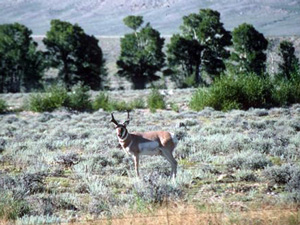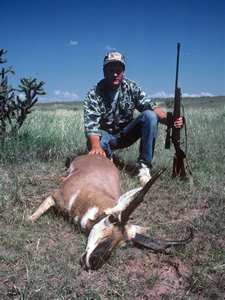
 If you live east of the Mississippi and travel west for your first pronghorn hunt, you're in for a treat. Rare is the hunter who is not awed by the sight of vast herds of these tan and white animals roaming the prairies. It's not unusual to see 100 or more antelope a day — quite a difference from a typical whitetail hunt where you might glimpse just a couple of animals in a hard day's hunt. It's a marvelous experience.
If you live east of the Mississippi and travel west for your first pronghorn hunt, you're in for a treat. Rare is the hunter who is not awed by the sight of vast herds of these tan and white animals roaming the prairies. It's not unusual to see 100 or more antelope a day — quite a difference from a typical whitetail hunt where you might glimpse just a couple of animals in a hard day's hunt. It's a marvelous experience.
But as a typical guided pronghorn trip unfolds, many hunters are dismayed at the technique employed. Almost without exception, vehicles are used for traveling, searching for game, and sometimes even for getting close to the quarry. Then a short stalk is made and the shot taken. Or maybe you're told to simply lean over the truck hood and squeeze the trigger.
One guide boasted to me that he sometimes drives 200 miles in a day's antelope hunting! And that's not to get to the area. That's after he's arrived, driving during the hunt.
It's all legal. And for elderly, infirm or handicapped hunters, it's certainly a good option. But for many other hunters, including myself, it's not a pleasant experience to spend 8-10 hours a day driving along rough roads and bouncing our kidneys up and down as we search for the quarry.
This is not to say that vehicles are inherently bad for use in antelope hunting. You certainly need one to get to the hunting area. It also comes in handy for retrieving the game if access is available without damaging fields. And in particularly flat territory or areas with sparser populations of animals, it may be appropriate to use a vehicle to get from one prime spot to the next one. But after that, it's time to get out and hunt on foot.
Even more preferable, when you can find an area with good antelope numbers and some rough terrain, I like to done broken-in hiking boots and a daypack and make the hunt entirely by foot power. Park the truck at dawn and don't come back until you bag your buck or the sun sets in the west.
The truth is there are some great overlooked bucks in remote spots that even 4x4 vehicles can't reach, places cut off by canyons or rough washouts. Get into those places on foot with a high-power pair of binoculars and spotting scope and you can enjoy an immensely rewarding hunt. It will leave you with a deep feeling satisfaction at the day's end after miles of hiking and glassing with only the sound of wind and the silent prairie to accompany you instead of the drone of a pickup engine. Instead of diesel fumes, the only thing you'll smell during your hunt is clean air and the sweet scent of sage.
It's a feeling you simply can't match if you drive around in a truck all day, spot a good pronghorn and shoot it without even breaking a sweat. If you'd rather have your legs aching at the end of the day than your rear end, try antelope hunting the challenging way: on foot.
 Due to the amount of pronghorn hunting that takes place on opening day, mostly from vehicles, I like to skip the first few days of the season when planning a hunt on foot. Let the truck hunters do their thing; most will fill their tags and go home within a day or two.
Due to the amount of pronghorn hunting that takes place on opening day, mostly from vehicles, I like to skip the first few days of the season when planning a hunt on foot. Let the truck hunters do their thing; most will fill their tags and go home within a day or two.
But all of their driving and shooting will push many good bucks up into the rough craggy breaks, canyons and plateaus where vehicles can't reach. Check with game wardens, taxidermists and wildlife biologists before the season to find out where some of these types of areas are, then buy or download from the Internet the appropriate maps.
What you want to avoid are areas with endless stretches of flat terrain and also regions with sparse antelope populations. You need some stalking cover and a good number of pronghorns to have a fun and successful foot hunt.
Of course some guides will also work with you to put together a hunt on foot, too. This will solve the access and pre-planning issues. Just make sure you clarify in advance that you want the vehicle to play only a limited role in the hunt, such as getting into the area and perhaps retrieving the antelope when it's down.
If you book a quality guide, he'll provide access to private lands where there are good numbers of animals. He'll also be a help in judging bucks, planning the stalk and retrieving the quarry.
Whether you hunt alone or with a guide, there are several tactics you can use. If you have time to scout the area and know where water holes are or where the local pronghorn crawl under fences, setting up an ambush in a blind or behind some sagebrush in those areas and waiting can be productive. This is particularly effective for bow hunting.
When I'm firearms hunting on foot, though, I almost always use the other major antelope hunting method--the classic glass-and-stalk technique. You see more of the captivating prairies this way, and get a greater thrill from actively pursuing the quarry.
Ridges and rough hills are a good place to start your search for game. Antelope use these areas regularly, and once the shooting starts, even more of them move to this craggy, broken habitat to escape pressure in flatter, more open terrain. These elevated areas also offer a tactical advantage of increased visibility for spotting game.
As you move along and glass from these high ridges and plateaus, be sure to stay slightly below the peak so you're not sky-lighted and easily visible to the antelope. Position yourself just down from the top, and then glass all the territory you can see. Use binoculars, then a spotting scope for more detailed analysis if you find animals. I like 10 or 12 power binoculars for the vast country you have to scour to find a good pronghorn buck, but 8-power will work if that's what you have.
As you glass pay particular attention to small bowls, folds, draws, knolls and swales. These are features you can't see with a casual glance with the naked eye, but they stand out clearly with good optics. They are all good spots to spot a small band of pronghorn or a lone buck that was kicked out of a more accessible area by vehicle hunters.
 Once you've covered a particular area thoroughly, move along to a fresh spot and repeat. When you spot a good buck, it's time to plan your strategy. If the antelope are moving towards you, just hunker down, find a good rest and wait. If they're moving away, calculate your stalk to try to intercept them. Plan a looping route that puts you near an ambush spot slightly ahead of them.
Once you've covered a particular area thoroughly, move along to a fresh spot and repeat. When you spot a good buck, it's time to plan your strategy. If the antelope are moving towards you, just hunker down, find a good rest and wait. If they're moving away, calculate your stalk to try to intercept them. Plan a looping route that puts you near an ambush spot slightly ahead of them.
The best bet is to find animals that are feeding leisurely and ready to bed down or already bedded. You can be pretty sure they'll be in that spot after you sneak into range out of sight. Use dry creek beds, small knolls and ridges and work your way around to get within range where you feel comfortable shooting, generally around 100-250 yards.
Make sure you work into or across wind, so the animals don't scent you. If you have to make some of the stalk in sight, get down low, kneeling and even crawling on your belly if necessary. Wearing knee pads helps protect you from cactus and stickers. When you get within a comfortable shooting distance, confirmed with a rangefinder, take a rest and carefully make the shot.
As you hunt on foot, be sure to pace yourself and don't try to cover too much territory. Moving too fast is a sure way to spook antelope. Ease up carefully to each new area you approach and glass it thoroughly before moving on.
As a rule, the best hunting comes during the first and last two hours of daylight. Pronghorns are up and visible then, easy to spot and less wary than they are during midday. Don't stop hunting during the brightest hours, just move more slowly. Watch some areas for up to half an hour before pushing forward to a fresh spot. Towards evening, pick up your pace again, checking areas more quickly for game on the move.
Sometimes a stalk may take an hour or more to execute. And when you get close enough, you may at the last moment decide he's not the animal you were hoping for.
But when you do finally sneak into range of a mature pronghorn buck and bag him with a clean shot after extensive walking and glassing in the animal's home turf, you'll experience one of the greatest thrills in hunting. Going one-on-one with America's premier plains animal, without using a truck, makes the feeling of accomplishment run especially deep when you wrap your hands around those thick, black horns and examine the rewards of the hard day's effort.
Pronghorn on Foot Preparations
|
- 4221 views

